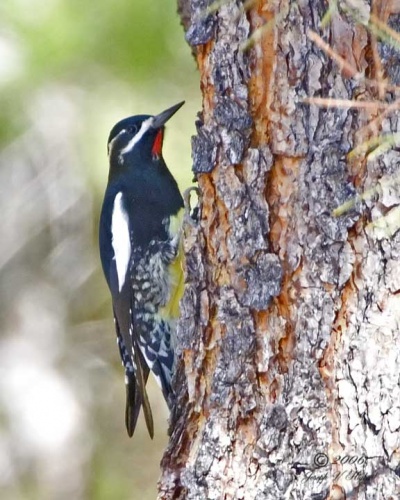(Clearer picture of female. User template. References updated) |
|||
| (One intermediate revision by one other user not shown) | |||
| Line 1: | Line 1: | ||
| + | [[Image:117506-1005wisa163.jpg|thumb|400px|right|Male<br />Photo {{user|jvhigbee|jvhigbee}}<br /> [[Washington]], [[USA]], October 2006]] | ||
;[[:Category:Sphyrapicus|Sphyrapicus]] thyroideus | ;[[:Category:Sphyrapicus|Sphyrapicus]] thyroideus | ||
| − | |||
| − | |||
==Identification== | ==Identification== | ||
Iridescent black head, back, sides and tail, white stripe behind the eye and a lower white stripe across each side of the head, red chin, bright yellow belly, black wings with large white patches. The female is completely different - black, pale yellow breast, brownish head with black streaking and fine barring on the back, breast and sides. | Iridescent black head, back, sides and tail, white stripe behind the eye and a lower white stripe across each side of the head, red chin, bright yellow belly, black wings with large white patches. The female is completely different - black, pale yellow breast, brownish head with black streaking and fine barring on the back, breast and sides. | ||
| Line 11: | Line 10: | ||
* S.t. thyroideus - southern [[British Columbia]] mountains to northern Baja; winters to northern [[Mexico]] | * S.t. thyroideus - southern [[British Columbia]] mountains to northern Baja; winters to northern [[Mexico]] | ||
* S.t. nataliae - southeastern [[British Columbia]] to the Rocky Mountains and Great Basin ranges of the [[USA]]. | * S.t. nataliae - southeastern [[British Columbia]] to the Rocky Mountains and Great Basin ranges of the [[USA]]. | ||
| − | + | [[Image:Williamson s SS f 9-16-16 IMG 6249web.jpg|thumb|350px|right|Female<br />Photo by {{user|Forcreeks|Forcreeks}}<br />]] | |
==Habitat== | ==Habitat== | ||
Open forested areas, including conifers. | Open forested areas, including conifers. | ||
| − | |||
==Behaviour== | ==Behaviour== | ||
* '''Breeding:''' They excavate a new nesting cavity each year, sometimes reusing the same tree. | * '''Breeding:''' They excavate a new nesting cavity each year, sometimes reusing the same tree. | ||
* '''Diet:''' Includes sap, mainly from conifers; insects are the main food source during the nesting season; berries are eaten outside of the breeding period. | * '''Diet:''' Includes sap, mainly from conifers; insects are the main food source during the nesting season; berries are eaten outside of the breeding period. | ||
==References== | ==References== | ||
| − | #{{Ref- | + | #{{Ref-Clements6thAug16}} |
{{Ref}} | {{Ref}} | ||
==External Links== | ==External Links== | ||
Latest revision as of 00:35, 24 September 2016
- Sphyrapicus thyroideus
Identification
Iridescent black head, back, sides and tail, white stripe behind the eye and a lower white stripe across each side of the head, red chin, bright yellow belly, black wings with large white patches. The female is completely different - black, pale yellow breast, brownish head with black streaking and fine barring on the back, breast and sides.
Distribution
Western North America, from southern British Columbia, Washington, and western Montana south to southern California, Arizona, and New Mexico. Uncommon in coastal areas.
Taxonomy
Two subspecies are recognized:[1]
- S.t. thyroideus - southern British Columbia mountains to northern Baja; winters to northern Mexico
- S.t. nataliae - southeastern British Columbia to the Rocky Mountains and Great Basin ranges of the USA.
Habitat
Open forested areas, including conifers.
Behaviour
- Breeding: They excavate a new nesting cavity each year, sometimes reusing the same tree.
- Diet: Includes sap, mainly from conifers; insects are the main food source during the nesting season; berries are eaten outside of the breeding period.
References
- Clements, J. F., T. S. Schulenberg, M. J. Iliff, D. Roberson, T. A. Fredericks, B. L. Sullivan, and C. L. Wood. 2016. The eBird/Clements checklist of birds of the world: v2016, with updates to August 2016. Downloaded from http://www.birds.cornell.edu/clementschecklist/download/
Recommended Citation
- BirdForum Opus contributors. (2024) Williamson's Sapsucker. In: BirdForum, the forum for wild birds and birding. Retrieved 25 April 2024 from https://www.birdforum.net/opus/Williamson%27s_Sapsucker





